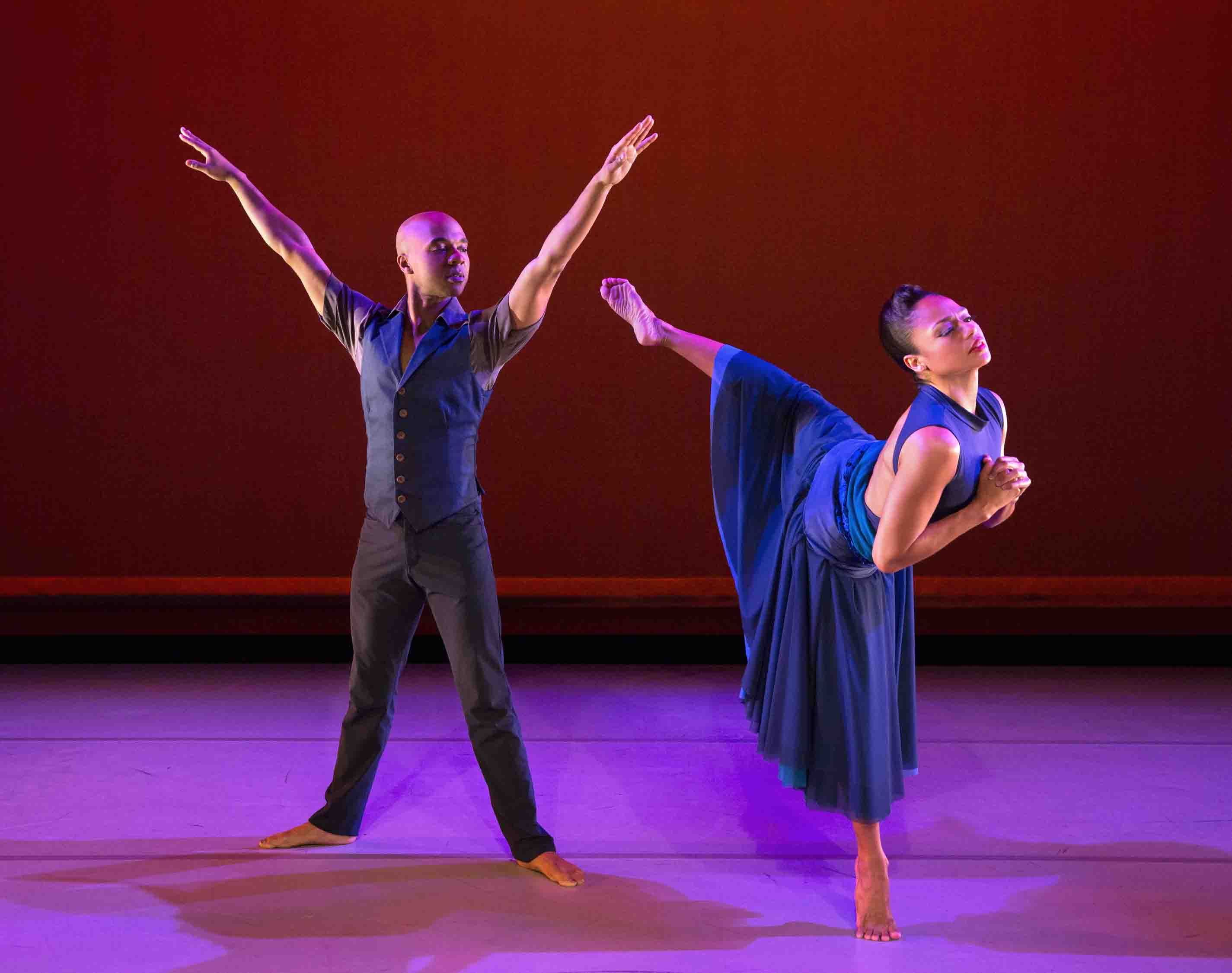
Matthew Rushing and Linda Celeste Sims in Open Door. Photo ©Paul Kolnik.
The Paramount Theater, Seattle – April 16, 2016
The first time that I saw the Alvin Ailey American Dance Theater was about ten years ago in New York City. There must’ve been other works on the program that night, but the one I remember the most was Revelations. Although at that time, I didn’t know much about African-American culture and the gospel churches, I felt like I understood their stories through their performance. The way they reached their arms straight up and grasped for something unreachable, or the way one crawled heavily on the ground with his back hunched up – their bodies spoke truthfully. Yet with words, I could not articulate what they had said.
Now, over a decade later, I wondered how I would react to Revelations. Since its premiere in 1960, only two years after Mr. Ailey formed the Alvin Ailey American Dance Theater, Revelations continues to be the company’s signature, though the company has since told stories through the voices of many choreographers. This evening’s program also presented two works created in 2015, Open Door, by Ronald K. Brown, and Awakening, by the company’s current artistic director, Robert Battle, as well as Love Songs (1972), a piece by Mr. Ailey exhibiting the Horton technique that anchors the company’s vocabulary.

Alvin Ailey American Dance Theater in Revelations. Photo ©Rosalie O’Connor
In Open Door, Brown was inspired by the music and dancing he observed in Cuba. Set to the sounds of big band Latin jazz by Arturo O’Farrill and the Afro-Latin Jazz Orchestra, Open Door captures the easy warmth of Cuban culture, through numbers that came and went like cool breezes. Dancing as couples, the dancers swiveled their hips playfully and seductively in variations of Latin dance steps. Costume designer Keiko Voltaire dressed the ladies in skirts that flared at each turn and vivid colours that matched their dance partners. In solo and ensemble numbers, the dancers had an equally good time, with upper bodies that snaked and shimmied to the funk grooves, African-styled drum rhythms and salsa beats. Yet, the reoccurring thrust of a straight arm, outstretched horizontally from the chest grounded them with a sense of purpose behind those smiles.
Love Songs is a solo, and was danced superbly by long-time company member, Glenn Allen Sims. It’s set to Poppies, sung by Nina Simone, and A Song For You and He Ain’t Heavy He’s My Brother, both sung by Donny Hathaway. The clarity in the piece comes from Sims’ presence and his attention to not over-embellish his movements, and also from the vocabulary of the Horton technique – I even saw Sims move through the ‘lateral T’ position – which draws its strength from the torso to stretch arms and legs in opposing directions. With one sweep of his arm, Sims seemed to shift time, and the dignity of his stance demonstrated power in simplicity. Such manner of movement, the songs, and Sims’ blue tank jumpsuit do date the piece to the early seventies, yet I believe Love Songs endures for the way it richly encapsulates that period of time.

Alvin Ailey American Dance Theater in Awakening. Photo ©Paul Kolnik
Awakening is Battle’s first creation since Judith Jamieson named him as her successor in 2011, though he had created several pieces for the company before. Dancer Jamar Roberts, who originated his role, led an ensemble of eleven dancers similarly dressed in shapeless white tops and pants. They became a uniform group with Roberts at its turbulent nucleus, whose tall stature commanded them like a gravitational force. Contorting his body, writhing on the ground, he then sprung up fighting with jerking motions, reaching with his legs and grasping with his hands, while the ensemble echoed his angst in frantic lunges and outstretched arms. John Mackey’s wild score brings to mind Igor Stravinsky’s The Rite of Spring, with bass strings strumming rhythmically against churning, high-pitched notes. Lighting designer Al Crawford raised the anxiety with a backdrop of rows of white LED lights and bright spotlights in an otherwise dark space. Battle’s swirling patterns of choreography increased in complexity and momentum as the piece progressed, and created a force of life and strength in the cold, mysterious setting.
Finally, Revelations more than revived nostalgia. I Been ‘Buked delivered one of the most memorable images of the evening – the ensemble stood, huddled close with feet rooted heavily into the ground, and arms that reached up then lowered successively in a staggered, staccato rhythm. The duet Fix Me Jesus was performed touchingly by Akua Noni Parker and Glenn Allen Sims, and expressed Sims’ faithful support toward Parker. When she balanced in arabesque on his thigh while he stood anchored in a wide second position, it evoked the strength they gave one another. Jamar Roberts delivered an affecting performance in I Wanna Be Ready, that honoured the precision of the choreography yet surrendered them to his rich interpretation. Sinner Man was an exhilarating trio performed with immense physicality by Colin Heyward, Chalvar Monteiro, and Kenji Segawa, who showed astounding speed and athleticism. Rocka My Soul in the Bosom of Abraham depicted the ladies and gentlemen at church in their Sunday best, fanning themselves on a humid day in the Deep South; a heart-warming celebration of gospel and one other. After more than a decade, tonight’s performance affirmed to me, that Revelations is indeed timeless. Yet the company’s voice rings equally strong and distinct in the other stories it tells.









No Comment